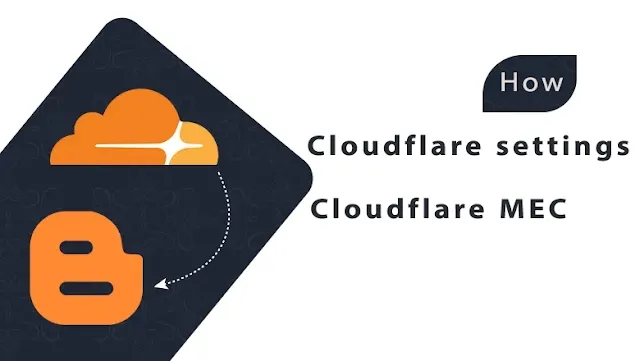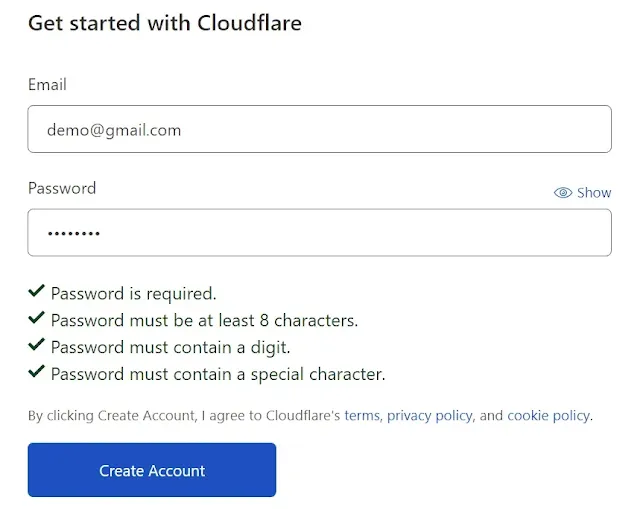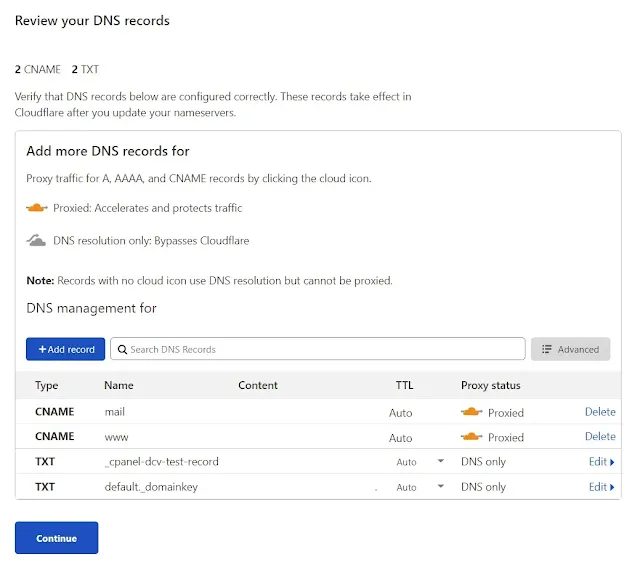How to Setup Cloudflare CDN with Blogger?
Without a doubt, the web has become a vital part of our daily lives, as we rely on the internet for many of our needs and the digital environment is evolving very rapidly. One of the important tools that helps speed up and improve the user experience on the web is the Cloudflare CDN service. If you run a blog on the Blogger platform, configuring and using the Cloudflare service can be a crucial step to improve the performance and security of your site.
In this article, we will learn how to set up Cloudflare CDN on your Blogger site? Follow the steps below carefully to enjoy a faster and more secure site. Before proceeding, let's first understand what Cloudflare is, and how it secures a website and increases the speed of the website.
Let's start our journey towards improving your blog by using the Cloudflare CDN service.
What is Cloudflare?
Cloudflare is a CDN (Content Delivery Network) company that provides a range of services to improve the performance and security of a website and blog. Its global network of servers helps deliver website content to visitors from the data center closest to them, resulting in faster loading times.
For example, let’s say you’re using Cloudflare CDN on your blog, and your hosting server is located in Iraq. If a visitor from the US wants to browse your blog, Cloudflare CDN will make your website data available to the visitor through its US data center, resulting in faster loading times. In other words, your site will load very quickly for the visitor.
Cloudflare CDN has around 152 data centers around the world, ensuring that visitors can access your website from the server closest to them, regardless of their location. This feature helps improve website performance and user experience.
Apart from improving website performance, Cloudflare also offers a range of security features to protect websites from various threats such as DDoS attacks, web application attacks, malicious traffic, or fake traffic such as bots, etc. It uses machine learning and artificial intelligence to identify and mitigate these threats in real-time.
Cloudflare also provides DNS management, SSL/TLS encryption, and analytics tools to help website owners monitor their website’s performance. These tools can help you identify and fix issues that may be affecting your website’s performance, ensuring your website runs smoothly and efficiently.
In short, Cloudflare CDN is a powerful tool that can help website owners improve website performance and security. With its global network of servers and suite of security features, Cloudflare CDN is an excellent choice for website owners who want to provide a seamless user experience for their visitors while ensuring their website is protected against various threats. Learn more about Cloudflare.
How Does Cloudflare CDN Improve Website Performance?
When you set up Cloudflare CDN for your website, you’re essentially adding an extra layer of optimization to your site’s performance. Cloudflare CDN works by storing your website’s static files (such as images, CSS stylesheets, and JavaScript) on its global network of servers, which are spread across multiple countries and regions.
When a visitor comes to your website, Cloudflare CDN automatically serves them static files from the server closest to them, rather than making them wait for the files to load from your server. This reduces the amount of time it takes for your website to load, which can have a huge impact on how quickly visitors interact with your site.
In addition to serving your static files, Cloudflare CDN also includes other optimization features that can speed up your website. For example, it can automatically minify your CSS and JavaScript files (which reduces their file size), and it can also compress your images so they load faster.
Overall, Cloudflare CDN can help significantly improve the performance and speed of your website, which can lead to a better user experience for your site visitors. It’s a simple and effective way to make your website faster and more reliable, without having to upgrade your server infrastructure.
Benefits of Using Cloudflare CDN with Blogger?
- Improved Website Speed: Cloudflare caches your website content on its servers and delivers it from the server closest to the user’s location, reducing latency and improving website speed.
- Better Website Performance: By distributing website content across multiple servers, Cloudflare reduces the load on your server and helps your website handle more traffic without slowing down or crashing.
- Enhanced Website Security: Cloudflare offers various security features such as SSL encryption, DDoS protection, and firewall protection to protect your website from cyber threats.
- Cost-effective: Cloudflare’s free plan offers basic CDN services, while its paid plans offer more advanced features at affordable prices, making it a cost-effective solution for bloggers.
- Ease of Setup: Setting up Cloudflare with Blogger is a straightforward process and does not require any technical knowledge. You can set up Cloudflare by following a few simple steps provided by Cloudflare.
How Does Cloudflare CDN Enhance Website Security?
First, Cloudflare CDN provides Distributed Denial of Service (DDoS) protection for websites. DDoS attacks can overload a website with traffic, making it inaccessible to users. With Cloudflare CDN, DDoS attacks are mitigated before they can reach a website, ensuring uninterrupted access to the website for its users.
Second, Cloudflare CDN provides Web Application Firewall (WAF) protection. A WAF protects websites from attacks that exploit vulnerabilities in web applications. Cloudflare’s WAF uses a set of rules to identify and block malicious traffic, providing an extra layer of security for a website.
Third, Cloudflare CDN provides Secure Sockets Layer (SSL) encryption for websites. SSL encryption ensures that data transmitted between a website and its users is encrypted and secure, preventing interception and unauthorized access to sensitive information.
Finally, Cloudflare CDN provides a feature called “I’m Under Attack Mode” that helps websites protect against more sophisticated attacks. When this mode is enabled, Cloudflare presents a challenge page to users, asking them to prove that they are not a robot before allowing them to access the website. This helps protect the website from attacks that are capable of bypassing other security measures.
Overall, Cloudflare CDN offers a comprehensive suite of security features that help protect websites from a range of threats. With Cloudflare CDN, website owners can have peace of mind knowing that their website is protected against malicious traffic and unauthorized access to sensitive information.
Who Should Use Cloudflare CDN?
Any website and blog owner who wants to improve the security and performance of their website and blog can use Cloudflare CDN. Its basic service is free, and there is no charge for it.
Cloudflare CDN can be activated for any type of website such as a Blogger/WordPress blog, any type of CMS, a personal website, a large corporate website, an e-commerce website, etc. Cloudflare is already included in the cPanel of most hosting companies, where you can activate Cloudflare for free. Its CDN can also be activated by subscribing to the Cloudflare website.
How to Setup Cloudflare CDN with Blogger
1. Create a Cloudflare account
Go to the official Cloudflare website and click on the Sign Up button, then register yourself with a strong email and password.
2. Enter your website name or domain
In this step, you have to enter the domain name/website address without www, i.e. demo.com and click on the "Add Website" button.
3. Choose plans (Paid is optional in our case we will choose Free as shown below)
In the Pro version, you will get enhanced firewall protection, image optimization, cache analytics, mobile optimizations, and more.
4. Setting up DNS in Cloudflare
Here Cloudflare will automatically add the required DNS settings for your website from your domain name registrar like GoDaddy or Namecheap and it will appear in your Cloudflare dashboard. Then click on the Continue button.
5. Change your default nameserver
After clicking on Continue, a new window will appear asking you to change your nameserver.
Now log in to your domain name service provider account (Here Godaddy) and go to DNS setup. Here you have to remove your default nameservers and add the nameserver provided by Cloudflare. If you are using (Namecheap), go to the (Domain List) box in the middle of the page then to (NAMESERVERSALERT / Custom DNS) then remove your default nameservers and add the nameserver provided by Cloudflare.
As shown in the image below, you have to select the option called "i'll use my own nameserver" and paste the nameserver provided by Cloudflare.
Now it may take some time for your domain activation to propagate the nameserver to Cloudflare. It usually takes an hour or in some cases up to 24 hours to transfer the entire nameserver.
Don't worry, Cloudflare will send you a confirmation email after the successful transfer of nameservers.
Now click on the Done Check Nameservers button in Cloudflare.
6. Configure Cloudflare Basic Settings
After following the above steps, Cloudflare asks you to enable some basic settings as shown below.
Enable the following options:-
- Automatically rewrite HTTPS
- Always use HTTPS
- Automatically minify (HTML, CSS, Javascript)
- Brotli (like Gzip compression)
You have now successfully connected your blog site to Cloudflare.
Also, if you face some problems you can check out how to fix broken, deleted and damaged links using Cloudflare
FAQs
- What is Cloudflare CDN and how does it work with Blogger?
- How can Cloudflare CDN improve the performance of my Blogger website?
- What are the benefits of using Cloudflare CDN with Blogger?
- How can Cloudflare CDN enhance the security of my Blogger website?
- Who should use Cloudflare CDN?
- How to set up Cloudflare CDN with Blogger?
- Is there any cost to use Cloudflare CDN with Blogger?
- Can I revert to my original DNS settings if I no longer want to use Cloudflare CDN with Blogger?
- Can I use Cloudflare CDN with a custom domain on Blogger?
- What are some common issues I may face when setting up Cloudflare CDN with Blogger?
Conclusion
Cloudflare CDN is a great way to improve page loading speed in Blogger and it is very easy to connect your Blogger site to Cloudflare.














Show Comments